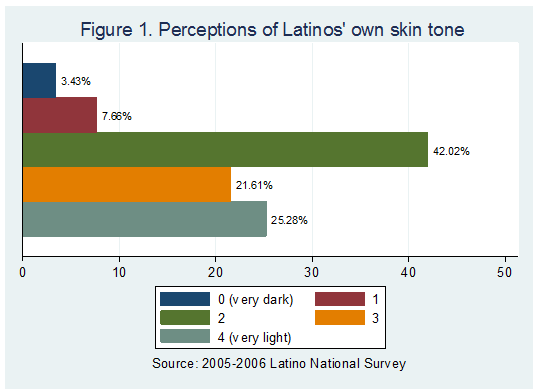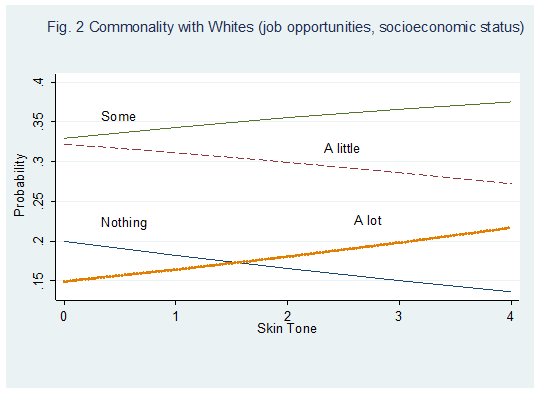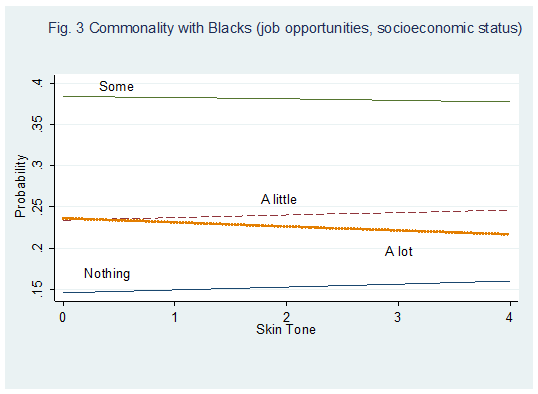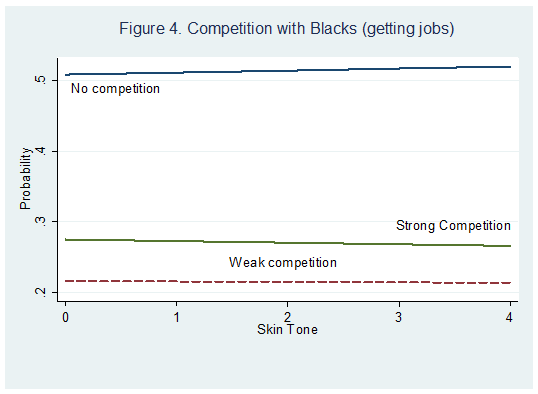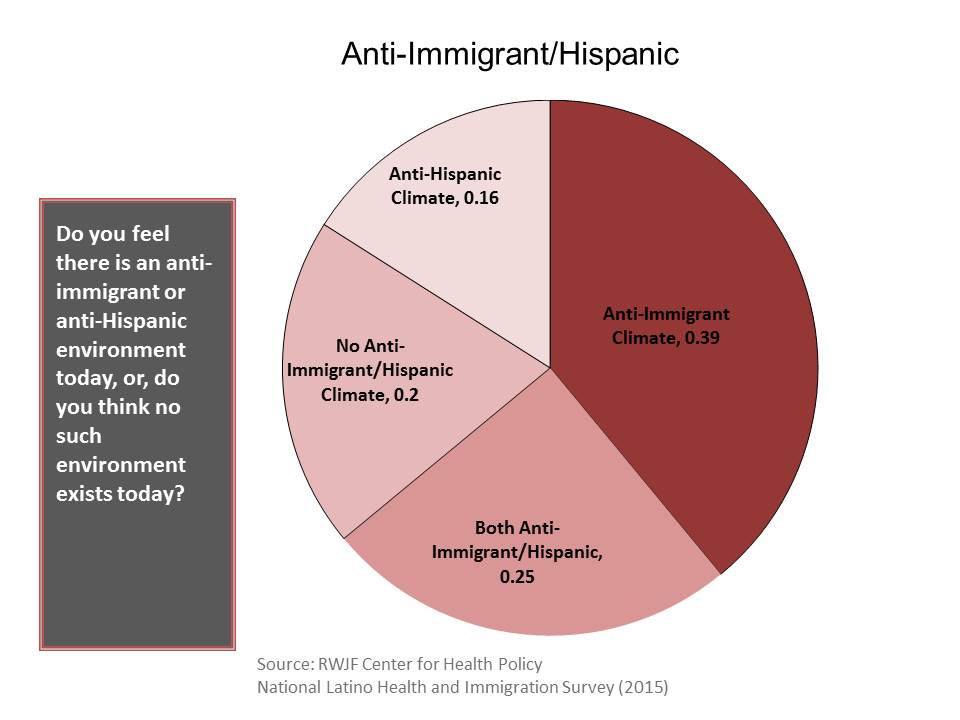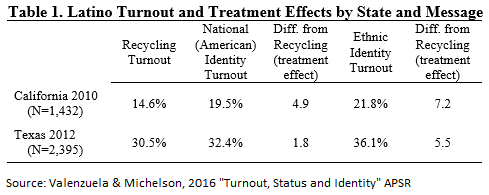By Betina C. Wilkinson, Wake Forest University
The Latino population in the U.S. differs in many ways- by national origin, socioeconomic status, native status, political ideology, and even skin tone. A recent Latino Decisions post by Gabriel Sanchez sheds light on another way that Latinos differentiate from each another: racial identification. More Latinos today are identifying as white racially, providing restored growth to the white population in a time where this may not be completely apparent. However, given that the census declares that Hispanic is not a race but an ethnicity, what influences Latinos to identify as white? Is it socioeconomic status and a sense of belonging as referred to in the aforementioned Latino Decisions post? Or can Latinos’ own skin tone impact their racial identification?
Skin tone differences among Latinos and its implications have been relatively untapped in the racial and ethnic politics literature. Furthermore, only recently have national surveys included questions about Latinos’ own perceptions of their skin tone. Examining individual self-perceptions is inherently different from exploring individuals’ actual skin tone. Nevertheless, studying individuals’ perceptions increases our understanding of the social desirability factors that influence how individuals perceive themselves and others (see Breland (1998) and Hochschild and Weaver, 2007)).
Using the 2005-2006 Latino National survey data, the figure below depicts Latinos’ self-perception of skin tone on a scale from 0 (very dark) to 4 (very light). As reflected in the figure, a majority of Latinos perceive their skin tone as not very dark nor as very light but somewhere in between, though a substantial number classify themselves as light and very light-skinned.
What do these findings mean? While they recognize differences in skin tone assessment among Latinos, the results displayed above have great implications for Latinos’ perceptions of others. Latinos’ self-perception of skin tone can significantly impact how they view others given that how individuals perceive themselves shapes their understanding of shared characteristics and/or circumstances with others (Wilkinson, Garand, and Dunaway, 2011). Perceptions of commonality and competition assess common characteristics and circumstances individuals have with others. In addition, they serve as precursors of coalition formation helping to develop our understanding of the potential coalition behavior among racial/ethnic groups (Meier and Stewart, 1991). Perceptions of commonality are likely to promote the development of political coalitions, yet perceptions of competition can serve as a detriment to the formation of coalitions (Kaufmann, 2003).
Hence, examining the effect of skin tone on these attitudes assists in explaining prejudices and behavior that relate directly to racial attitudes but are seldom addressed directly in the racial attitudes literature in political science (Wilkinson, Garand and Dunaway, 2011). So, to what extent does skin tone impact Latinos’ perceptions of commonality and competition with African Americans and whites?
Using the 2005-2006 Latino National Survey, I illustrate the effect of Latinos’ self-perception of skin tone on their commonality with whites and blacks regarding job opportunities and socioeconomic status and employment competition with African Americans. Figure 2 and 3 depict commonality with whites and blacks (respectively) as it pertains to employment opportunities, educational attainment and income. Figure 4 illustrates Latino competition with African Americans in getting jobs. These figures present predicted probabilities associated with outcomes of the commonality and competition variables for different values of the skin tone variable. I generate the probabilities holding other variables (age, gender, income, time in the U.S. and linked fate with Latinos) constant at their means.
As one can see in Figure 2, as skin tone moves in the “light” direction, high commonality with whites regarding job opportunities and socioeconomic status increases. Similarly when skin tone changes from very dark to very light, low commonality with whites declines among Latinos. Clearly, skin tone significantly influences whether Latinos perceive that they have something in common with whites as it relates to job opportunities and socioeconomic status.
Figures 3 and 4 illustrate Latino commonality and competition with African Americans as dictated by skin tone. When it comes to Latinos’ commonality with blacks (socioeconomic status and employment opportunities), as skin tone changes from very dark to very light, high commonality with blacks decreases. Though these relationships are not as robust as those found in Figure 1 regarding commonality with whites, dark-skinned Latinos may be more likely to perceive commonality with African Americans regarding job opportunities and socioeconomic attainment than light-skinned Latinos.
With regards to Latinos’ employment competition with blacks, the results are not as clear. As skin tone moves in the “light” direction, strong competition with African Americans decreases slightly and no competition escalates to some degree. Nonetheless, further research must be conducted as to the relationship between skin tone and employment competition with blacks.
The figures presented above portray preliminary analyses of skin tone and Latino perceptions of commonality and competition with African Americans and whites. However, they prompt a few critical points. First, Latinos differ in their self-perception of skin tone. Not all Latinos perceive their skin tone in the same way though a substantial number identify as being somewhat in between very dark and very light. Second, skin tone seems to play a significant role in shaping Latinos’ commonality with whites. Furthermore, given that light skinned Latinos perceive greater commonality with whites than dark skinned Latinos, tensions between light skinned Latinos and whites may not be too great. Lastly, skin tone does not clearly explain Latinos’ commonality and competition with blacks regarding jobs. Other factors may impact their attitudes toward blacks. However, it is important to note that there may be some tension between dark skinned Latinos and African Americans regarding jobs, and this may be due to the fact that dark skinned Latinos perceive to have a similar socioeconomic situation as African Americans. Future studies should further explore the relationship between perceptions of commonality and competition as mediated by skin tone since they may be interrelated and not be as opposing precursors of coalition formation as some have framed them to be.
Betina C. Wilkinson is an Assistant Professor of Political Science at Wake Forest University.
Works Cited in Post
Breland, Alfiee. 1998. A Model for Differential Perceptions of Competence Based on Skin Tone Among African Americans. Journal of Multicultural Counseling and Development, 26, 4.
Hochschild, JL, Weaver V. 2007. The Skin Color Paradox and the American Racial Order, 12/2007. Social Forces. 86(2):643-670.
Kaufmann, Karen M. 2003. “Cracks in the Rainbow: Perceived Commonality as a Basis for Latino and African-American Political Coalitions.” Political Research Quarterly 56:2:199-210.
Meier, Kenneth J., and Joseph Stewart, Jr., 1991, “Cooperation and Conflict in Multiracial School Disticts,” Journal of Politics 53: 1123-1133.
Wilkinson, Betina Cutaia, Jim Garand and Johanna Dunaway. 2011. “Does Skin Tone Shape Individuals’ Perceptions of Commonality and Competition with other Racial and Ethnic Groups?”
Manuscript under Review.

